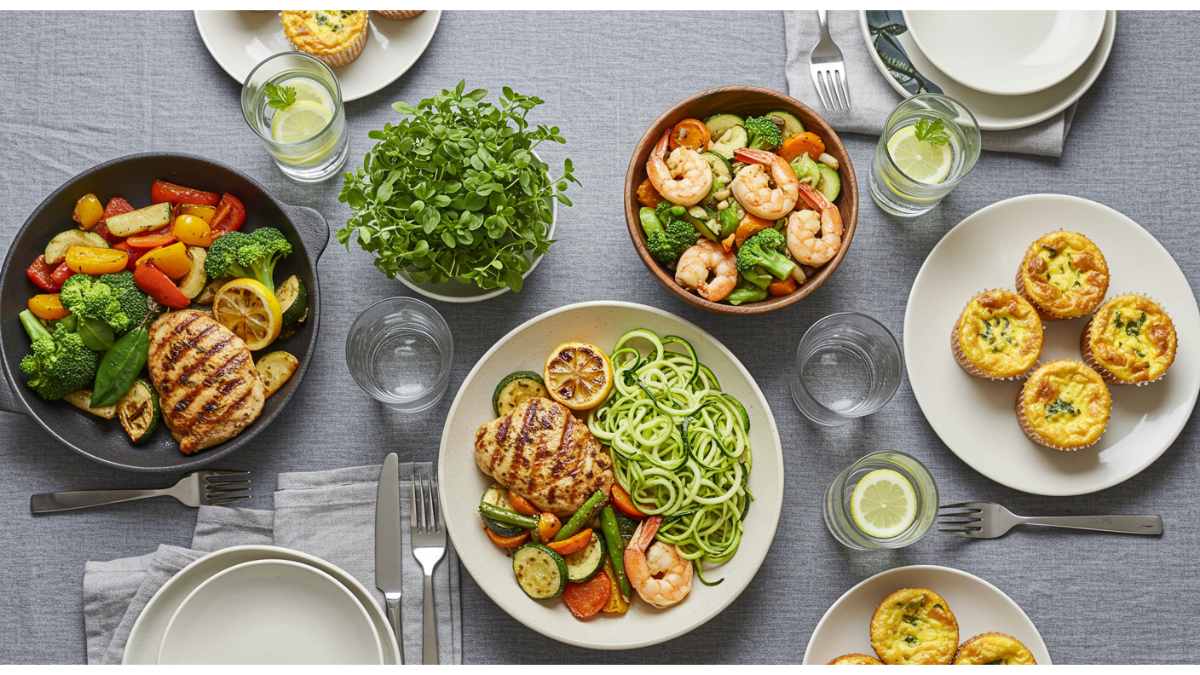Savor the Benefits of 3 High Protein Low Carb Recipes for Ultimate Nutrition
In today’s health-conscious world, finding the right balance between macronutrients is essential for achieving your fitness goals. High protein low carb recipes have gained popularity among those looking to lose weight, build muscle, or simply maintain a healthy lifestyle. These meals are not only nutritious but also incredibly satisfying, ensuring you stay full and energized throughout the day. In this article, I will share 20 delicious high protein low carb recipes that you can easily incorporate into your meal plan, along with valuable tips and insights to enhance your culinary experience.
The rise of the low-carb trend has been fueled by numerous studies highlighting the benefits of reducing carbohydrate intake, particularly refined carbs and sugars. This dietary approach emphasizes whole foods, protein-rich ingredients, and healthy fats, allowing individuals to experience improved satiety and energy levels.
As someone who has navigated the world of nutrition, I can attest to the transformative power of high protein low carb recipes. They not only support weight management but also contribute to overall well-being. Whether you’re an experienced cook or just starting your culinary journey, these recipes will inspire you to create satisfying meals that align with your health goals.
Key Aspects of High Protein Low Carb Recipes

High protein low carb recipes are designed to provide your body with the necessary nutrients while minimizing carbohydrate intake. This method offers numerous health advantages, such as:
- Weight Management: By reducing carbs and increasing protein, you can promote fat loss while preserving lean muscle mass. Studies have shown that diets high in protein can lead to greater weight loss compared to those that are lower in protein.
- Improved Satiety: Protein-rich foods tend to keep you feeling fuller for longer, reducing the likelihood of snacking between meals. When you consume a meal high in protein, your body releases hormones that signal fullness, helping you resist cravings.
- Enhanced Metabolism: A higher protein intake can boost your metabolism, leading to more calories burned throughout the day. This phenomenon, known as the thermic effect of food (TEF), means your body expends energy to digest and metabolize protein.
- Blood Sugar Control: Low carb diets can help stabilize blood sugar levels, making them a suitable option for individuals with insulin resistance or diabetes. By limiting carbohydrates, you can reduce spikes in blood sugar, leading to more stable energy levels.
- Muscle Preservation: For those engaged in strength training or high-intensity workouts, a high protein diet is crucial for muscle recovery and growth. Consuming adequate protein helps repair muscle fibers and supports overall performance.
Ingredients You’ll Need for High Protein Low Carb Recipes
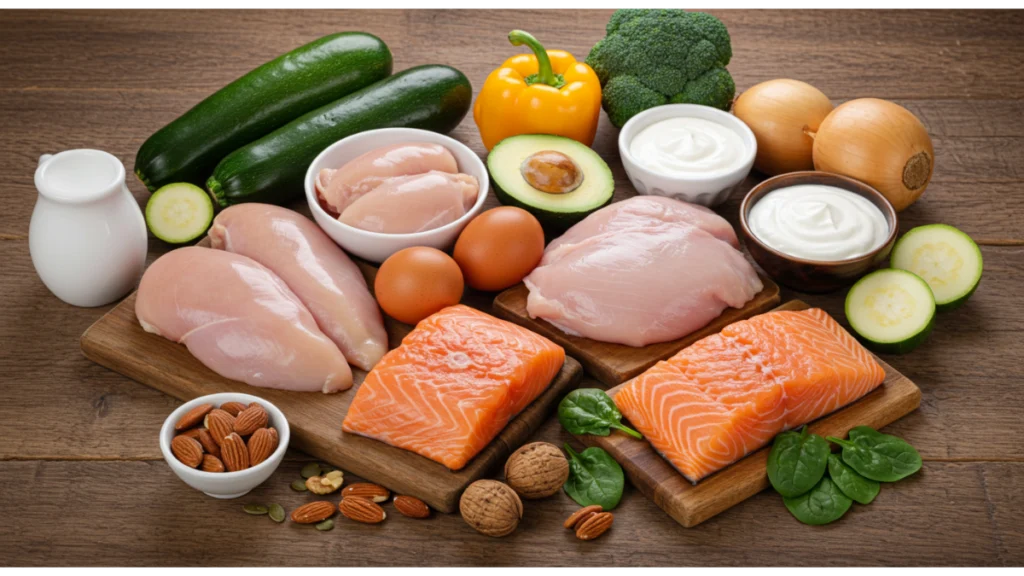
Creating high protein low carb meals requires a selection of nutrient-dense ingredients. Here’s a list of staples you should consider:
- Lean Proteins: Chicken breast, turkey, and low-fat beef cuts serve as outstanding protein sources. They are low in fat and can be prepared in various ways to suit your taste preferences.
- Fish: Salmon, tuna, and tilapia are not only rich in protein but also provide healthy omega-3 fatty acids, which are beneficial for heart health.
- Eggs: Eggs are a versatile ingredient packed with protein and essential nutrients. They can be used in breakfast dishes, salads, and even baked goods.
- Dairy Products: Greek yogurt and cottage cheese are high in protein and can be enjoyed as snacks, breakfast items, or incorporated into recipes for added creaminess.
- Nuts and Seeds: Almonds, chia seeds, and flaxseeds are great sources of protein and healthy fats. They can be incorporated into smoothies, tossed in salads, or enjoyed as convenient snacks.
- Low-Carb Vegetables: Spinach, broccoli, cauliflower, and zucchini are nutrient-dense vegetables that can be used in various dishes to add volume and fiber without the carbs.
- Healthy Fats: Olive oil, avocado, and coconut oil provide essential fatty acids that support overall health and enhance the flavor of your meals.
Step-by-Step Instructions to Make High Protein Low Carb Recipes
Here are three sample recipes with detailed instructions to get you started:
1. Grilled Lemon Herb Chicken
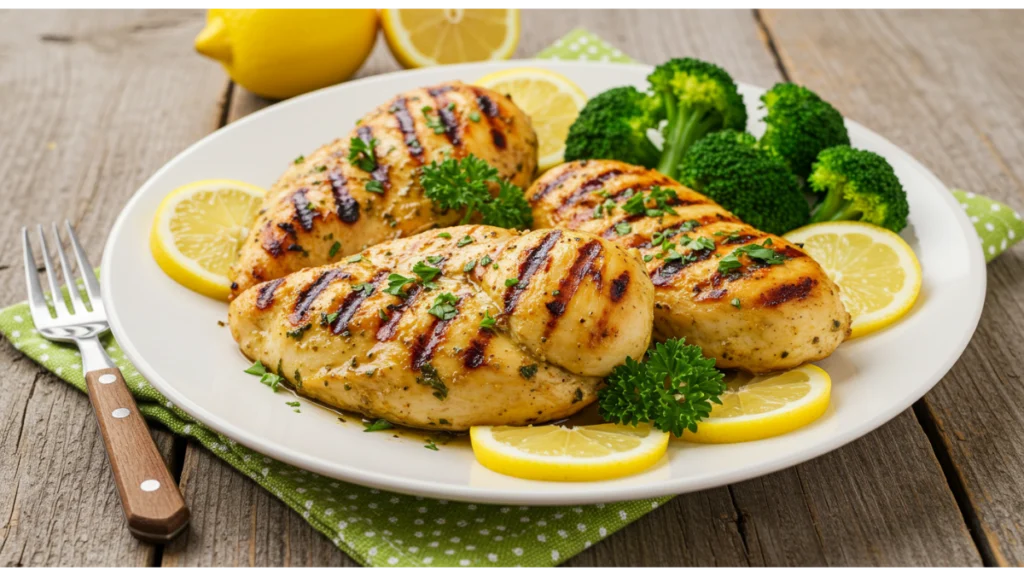
Ingredients:
- 4 chicken breasts
- 2 lemons (juiced)
- 2 tablespoons olive oil
- 2 teaspoons dried oregano
- Salt and pepper to taste
- Fresh parsley for garnish
Instructions:
- In a bowl, mix lemon juice, olive oil, oregano, salt, and pepper to create a marinade.
- Place the chicken breasts in a resealable plastic bag or a shallow dish, then pour the marinade over them. Seal the bag or cover the dish and refrigerate for at least 30 minutes (up to 4 hours for more flavor).
- Preheat the grill to medium-high heat. Lightly oil the grill grates to prevent sticking.
- Take the chicken out of the marinade and throw away the leftover marinade. Grill the chicken for 6-7 minutes on each side or until fully cooked (internal temperature should reach 165°F or 74°C).
- Take the chicken off the grill and let it rest for about 5 minutes before slicing. Serve with a side of steamed broccoli or a fresh salad, garnished with fresh parsley.
2. Zucchini Noodles with Pesto and Shrimp
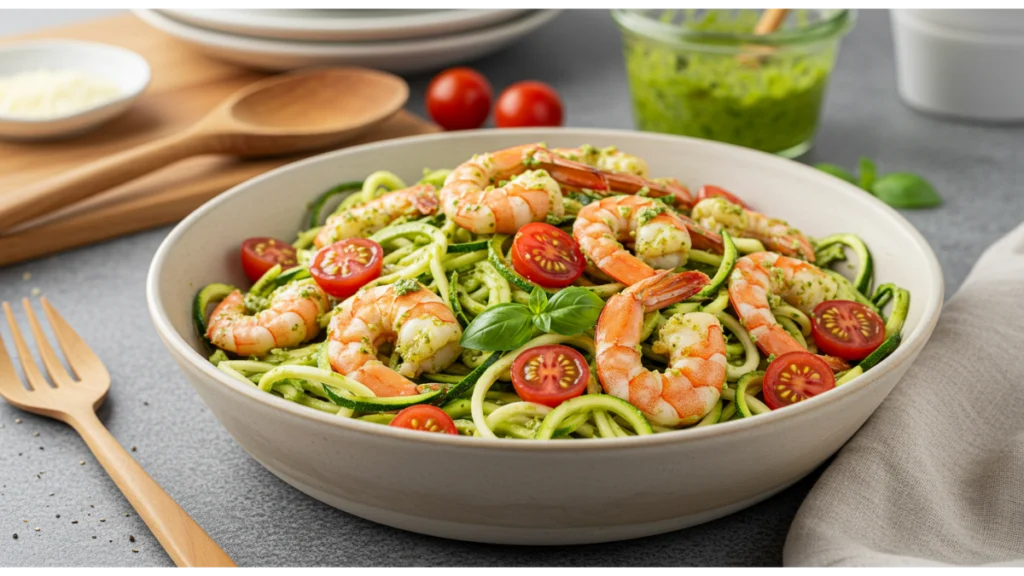
Ingredients:
- 2 medium zucchinis (spiralized)
- 1 pound shrimp (peeled and deveined)
- 1/4 cup pesto sauce
- 2 tablespoons olive oil
- Salt and pepper to taste
- Cherry tomatoes for garnish (optional)
Instructions:
- In a large skillet, warm olive oil over medium heat. Add the shrimp, seasoning them with salt and pepper. Cook for approximately 3-4 minutes, or until the shrimp become pink and opaque. Then, add the spiralized zucchini to the skillet and mix it with the shrimp.
- Remove the skillet from heat and stir in the pesto sauce, ensuring the noodles and shrimp are well coated.
- Serve immediately, garnished with cherry tomatoes if desired. This meal is light, tasty, and ideal for a quick dinner during the week.
3. Egg Muffins with Spinach and Feta
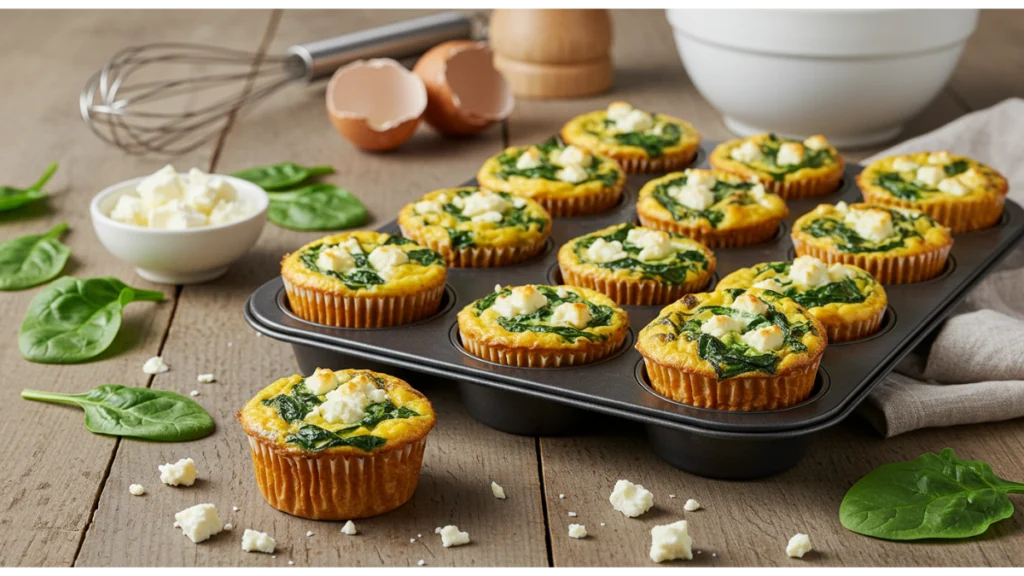
Ingredients:
- 6 large eggs
- 1 cup fresh spinach (chopped)
- 1/2 cup feta cheese (crumbled)
- Salt and pepper to taste
- Cooking spray or olive oil for coating the muffin tin
Instructions:
- Preheat the oven to 350°F (175°C). Coat a muffin tin with cooking spray or olive oil to avoid sticking.
- In a mixing bowl, whisk together the eggs, chopped spinach, feta cheese, salt, and pepper until well combined.
- Evenly distribute the egg mixture into the prepared muffin tin, filling each cup about 3/4 full. Bake for 20-25 minutes or until the egg muffins are firm and lightly golden on top. Let them cool slightly before taking them out of the tin. These muffins can be stored in the refrigerator for up to 4 days and make for a convenient breakfast option.
Nutritional Value
| Ingredient | Protein (g) | Carbs (g) | Fat (g) | Benefits |
|---|---|---|---|---|
| Chicken Breast | 26 | 0 | 3 | Lean protein source, low in calories |
| Shrimp | 24 | 1 | 1 | Rich in omega-3 fatty acids |
| Eggs | 6 | 1 | 5 | Excellent source of protein and vitamins |
| Spinach | 3 | 1 | 0 | High in vitamins A, C, and K |
| Feta Cheese | 4 | 1 | 6 | Adds flavor and calcium |
| Zucchini | 2 | 4 | 0 | Low in calories, high in fiber |
| Olive Oil | 0 | 0 | 14 | Healthy fat that supports heart health |
Benefits of High Protein Low Carb Recipes
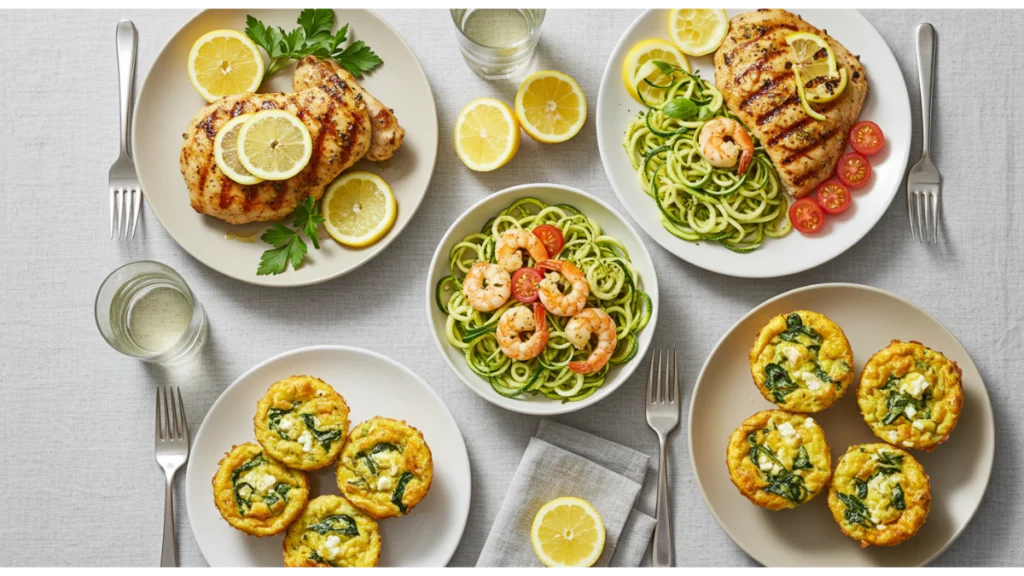
- Weight Loss: Many individuals have found success in shedding pounds by following a high protein low carb diet. By focusing on protein, you can reduce cravings and maintain muscle mass. Research indicates that high protein diets can lead to greater fat loss compared to traditional calorie-restricted diets.
- Muscle Building: For those looking to gain strength, incorporating these recipes into your diet can support muscle recovery and growth. Protein is essential for repairing muscle tissue after workouts, making it a crucial component of any fitness regimen.
- Sustained Energy Levels: These meals provide a steady source of energy without the spikes and crashes associated with high-carb diets. By stabilizing blood sugar levels, you can avoid energy slumps that often occur after consuming high-carb foods.
- Improved Mental Clarity: A diet low in carbohydrates can help improve cognitive function and mental clarity. Many individuals report enhanced focus and concentration when following a low-carb, high-protein diet.
- Reduced Inflammation: High protein low carb diets often include anti-inflammatory foods, which can help reduce chronic inflammation in the body. This is particularly beneficial for individuals with autoimmune conditions or those seeking to improve overall health.
Overcoming Challenges
Transitioning to a high protein low carb diet may come with challenges, such as cravings for carbohydrates. Below are some effective strategies to tackle these challenges:
- Meal Prep: Prepare meals in advance to ensure you have healthy options readily available. Spend a few hours each week planning and preparing your meals, making it easier to stick to your dietary goals.
- Stay Hydrated: At times, your body may confuse thirst for hunger. Ensure you drink sufficient water throughout the day to stay hydrated and manage cravings effectively.
- Experiment with Flavors: Use herbs and spices to enhance the taste of your meals, making them more enjoyable. Fresh herbs like basil, cilantro, and parsley can add depth to your dishes without adding extra calories.
- Find Alternatives: If you find yourself craving traditional high-carb foods, look for low-carb alternatives. For example, use cauliflower rice instead of regular rice or almond flour instead of wheat flour in baking.
Future Trends in High Protein Low Carb Recipes
As dietary preferences evolve, we can expect to see more innovative high protein low carb recipes emerging. Some potential trends include:
- Plant-Based Proteins: The rise of plant-based diets will lead to more recipes featuring ingredients like lentils, chickpeas, and tofu. These ingredients can provide ample protein while keeping carbohydrate levels in check.
- Functional Foods: Ingredients that offer additional health benefits, such as probiotics and superfoods, will likely be incorporated into recipes. Foods like fermented vegetables and chia seeds can enhance the nutritional profile of your meals.
- Meal Kits: Convenience will drive the popularity of meal kits that focus on high protein low carb options, making healthy eating more accessible. Many meal kit services now offer low-carb options that simplify meal planning and preparation.
- Global Flavors: As culinary exploration continues, expect to see more high protein low carb recipes inspired by global cuisines. Dishes from Mediterranean, Asian, and Latin American cultures can add variety and excitement to your meal plan.
- Smart Cooking Appliances: The rise of smart kitchen gadgets, such as air fryers and instant pots, will make it easier to prepare high protein low carb meals quickly and efficiently. These appliances can help streamline cooking processes and enhance flavor.
Tips and Tricks Section
- Use a Food Scale: Accurately measure your ingredients to maintain portion control. This can help you stay on track with your macronutrient goals and prevent overeating.
- Flavor Enhancements: Incorporate lemon juice, vinegar, or hot sauce to add flavor without extra calories. These ingredients can elevate the taste of your dishes while keeping them low in carbs.
- Explore New Ingredients: Try using alternative flours like almond or coconut flour in recipes. These flours are low in carbs and can be used to create delicious baked goods without compromising your dietary goals.
- Batch Cooking: Prepare large quantities of your favorite high protein low carb recipes and freeze portions for later. This ensures you always have healthy meals on hand, even on busy days.
Variations and Adaptations
Here are some diet-friendly variations you can try:
- Gluten-Free: Substitute regular pasta with zucchini noodles or spaghetti squash. These alternatives are low in carbs and can be easily incorporated into your favorite pasta dishes.
- Vegetarian: Replace meat with plant-based protein sources like tempeh or tofu. These ingredients provide a hearty texture and can absorb flavors well in various dishes.
- Dairy-Free: Use nutritional yeast in place of cheese for a cheesy flavor without the dairy. Nutritional yeast is rich in B vitamins and adds a savory taste to dishes.
- Keto-Friendly: Adjust recipes to fit a ketogenic diet by focusing on high-fat ingredients like avocados, nuts, and seeds. This can help you reach and maintain ketosis while enjoying delicious meals.
FAQs
u003cstrongu003eQ: Can I substitute chicken with turkey in recipes?u003c/strongu003e
A: Yes, turkey is an excellent high-protein alternative to chicken. It can be used in most recipes that call for chicken, providing similar flavor and texture.
u003cstrongu003eQ: How do I store leftovers?u003c/strongu003e
A: Store leftovers in an airtight container in the refrigerator for up to 3 days. Reheat thoroughly before consuming to ensure food safety.
u003cstrongu003eQ: Are there any quick high-protein snacks?u003c/strongu003e
A: Absolutely! Consider options like Greek yogurt, cottage cheese, or hard-boiled eggs. These snacks are simple to make and rich in protein.
u003cstrongu003eQ: Can I follow a high protein low carb diet while eating out?u003c/strongu003e
A: Yes, many restaurants offer high protein low carb options. Look for grilled meats, salads, and vegetable-based dishes. Feel free to modify your order by requesting substitutions.
u003cstrongu003eQ: What are some good sources of plant-based protein?u003c/strongu003e
A: Some excellent sources of plant-based protein include lentils, chickpeas, quinoa, edamame, and hemp seeds. These ingredients can be incorporated into salads, soups, and main dishes.
Conclusion
High protein low carb recipes are a fantastic way to nourish your body while enjoying delicious meals. By incorporating these recipes into your meal plan, you can achieve your health goals without sacrificing flavor. I encourage you to try out these recipes, share your experiences, and explore new culinary adventures in the world of healthy eating.
Embrace the journey of discovering high protein low carb meals that not only satisfy your taste buds but also support your overall health and wellness. Remember, the key to success lies in variety, creativity, and a willingness to experiment in the kitchen.

High Protein Low Carb Recipes
Ingredients
Grilled Lemon Herb Chicken
- 4 pieces chicken breasts Lean protein source
- 2 pieces lemons (juiced) For marinade
- 2 tablespoons olive oil Healthy fat
- 2 teaspoons dried oregano For seasoning
- Salt and pepper to taste
- Fresh parsley for garnish
Zucchini Noodles with Pesto and Shrimp
- 2 medium zucchinis (spiralized) Low-carb alternative
- 1 pound shrimp (peeled and deveined) Excellent protein source
- 1/4 cup pesto sauce For flavor
- 2 tablespoons olive oil Healthy fat
- Salt and pepper to taste
- Cherry tomatoes for garnish (optional)
Egg Muffins with Spinach and Feta
- 6 large eggs High in protein
- 1 cup fresh spinach (chopped) Nutrient-dense
- 1/2 cup feta cheese (crumbled) Adds flavor
- Salt and pepper to taste
- Cooking spray or olive oil for coating the muffin tin
Instructions
Grilled Lemon Herb Chicken
- In a bowl, mix lemon juice, olive oil, oregano, salt, and pepper to create a marinade.
- Place the chicken breasts in a resealable plastic bag or a shallow dish, then pour the marinade over them. Seal the bag or cover the dish and refrigerate for at least 30 minutes.
- Preheat the grill to medium-high heat. Lightly oil the grill grates to prevent sticking.
- Take the chicken out of the marinade and throw away the leftover marinade. Grill the chicken for 6-7 minutes on each side or until fully cooked.
- Let it rest for 5 minutes before slicing. Serve with steamed broccoli or salad.
Zucchini Noodles with Pesto and Shrimp
- In a large skillet, warm olive oil over medium heat. Add the shrimp, seasoning them with salt and pepper. Cook for 3-4 minutes.
- Add the spiralized zucchini to the skillet and mix it with the shrimp.
- Remove from heat and stir in the pesto sauce.
- Serve immediately, garnished with cherry tomatoes if desired.
Egg Muffins with Spinach and Feta
- Preheat the oven to 350°F (175°C). Coat a muffin tin with cooking spray or olive oil.
- In a mixing bowl, whisk together the eggs, chopped spinach, feta cheese, salt, and pepper.
- Evenly distribute the mixture into the muffin tin, filling each cup about 3/4 full. Bake for 20-25 minutes.
- Let cool slightly before removing from the tin.

